Hunter Engineering Company - Hunter története napjainkban
In 1992, Hunter's first generation PC-based aligner featuring Hunter WinAlign® Software opened the door to a new age of aligner capabilities. The first generation WinAlign Software operated on Hunter's Series 211, the industry's first aligner based on a Windows® operating system platform. WinAlign Software sped the alignment process by automating many steps that before were performed manually by the technician.
WinAlign Software automatically calculates toe and center steer, shims and bushings, and even selects the tools and kits required to complete each alignment before the technician starts the job. Illustrations, photos, computer animation and video instructions, all specific to the vehicle being aligned, are available at the touch of a key. WinAlign Software is the winner of multiple automotive and computer industry awards.
 Nearly 50 years after Lee Hunter founded Hunter Engineering Company, he was inducted into the Automotive Hall of Fame in Dearborn, Michigan. In this shrine of automotive history, Lee Hunter shares the spotlight with industry giants like Henry Ford, Louis Chevrolet, Walter P. Chrysler and Soichiro Honda. The Hall of Fame places Hunter among “individuals who have made a dramatic impact on the development of the automobile and the automotive industry…” Nearly 50 years after Lee Hunter founded Hunter Engineering Company, he was inducted into the Automotive Hall of Fame in Dearborn, Michigan. In this shrine of automotive history, Lee Hunter shares the spotlight with industry giants like Henry Ford, Louis Chevrolet, Walter P. Chrysler and Soichiro Honda. The Hall of Fame places Hunter among “individuals who have made a dramatic impact on the development of the automobile and the automotive industry…”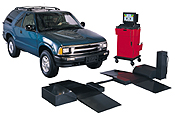
In 1993, Hunter Engineering introduced two new technologies: “cordless communication” to alignment sensors and the use of the digital signal processor in its new line of DSP wheel balancers. Two years later, Hunter began shipping its SA400 Computerized Suspension Analyzer to customers. The SA400 measures suspension adhesion and damping performance in a two minute drive-on test and is powered by the same Windows® operating system platform used for Hunter aligners.
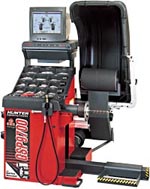 Hunter again revolutionized wheel vibration control in 1997 by employing technology and creative solutions to meet a basic customer need. The GSP9700 Vibration Control System is a state-of-the-art wheel balancer that features a computer-simulated road test that measures and isolates non-balance-related wheel vibration. Wheel vibration is a major source of car owner complaints for service and tire shops and vehicle manufacturers. The GSP9700 is the first affordable shop tool for measuring wheel force variation caused by runout or uneven stiffness in the tire tread or sidewall. Hunter again revolutionized wheel vibration control in 1997 by employing technology and creative solutions to meet a basic customer need. The GSP9700 Vibration Control System is a state-of-the-art wheel balancer that features a computer-simulated road test that measures and isolates non-balance-related wheel vibration. Wheel vibration is a major source of car owner complaints for service and tire shops and vehicle manufacturers. The GSP9700 is the first affordable shop tool for measuring wheel force variation caused by runout or uneven stiffness in the tire tread or sidewall.
By 2002 the GSP9700 evolved from just vibration control to total Road Force Measurement® with the addition of the StraightTrak® Lateral Force Measurement feature. StraightTrak LFM measures lateral forces in tires that cause pulls and drifts and calculates a tire placement plan to produce the least amount of net lateral force and systematically eliminate these problems. The versatility of the StraightTrak LFM enables a technician to integrate this valuable information into tire mounting and balancing processes, tire rotations and alignment service.
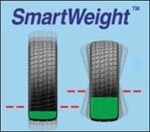 In 2005 Hunter introduced SmartWeight™ Balancing Technology for all GSP series balancers. SmartWeight technology elevated the expectations of balancing service by providing superior wheel balancing results while presenting money-saving advantages never available before in a wheel balancer. In 2005 Hunter introduced SmartWeight™ Balancing Technology for all GSP series balancers. SmartWeight technology elevated the expectations of balancing service by providing superior wheel balancing results while presenting money-saving advantages never available before in a wheel balancer. 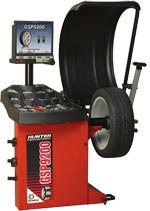 SmartWeight technology’s unique method of balancing minimizes the amount of wheel weight needed to correct an imbalance and reduces the time required to perform the service. With SmartWeight technology, service shops can perform more quality balances in less time and save on labor and materials in the process. SmartWeight technology’s unique method of balancing minimizes the amount of wheel weight needed to correct an imbalance and reduces the time required to perform the service. With SmartWeight technology, service shops can perform more quality balances in less time and save on labor and materials in the process.
Hunter's newest Futóműállító rendszerek feature a 32-bit version of WinAlign® Software, DVD drive and MPEG-2 digital video compression technology. Three-dimensional live animation models support real-time alignment adjustment features. Digital photos and video features support instant access to user instruction and training, including symptom-based diagnostic help. A shop management feature handles back office management chores. With optional network cards and a modem, Hunter aligners are network- and internet- capable.
 Hunter introduced digital imaging technology to its product line in 1998 to speed and simplify alignment service. The patented four-camera system is contained in an elevated housing to keep the electronics out of harm's way. Technicians only handle the durable wheel-mounted, reflective targets. Using the digital technology to gather vehicle measurements and make adjustments allows technicians to complete an alignment in nearly half the time as when using conventional on-the-wheel sensors. Hunter introduced digital imaging technology to its product line in 1998 to speed and simplify alignment service. The patented four-camera system is contained in an elevated housing to keep the electronics out of harm's way. Technicians only handle the durable wheel-mounted, reflective targets. Using the digital technology to gather vehicle measurements and make adjustments allows technicians to complete an alignment in nearly half the time as when using conventional on-the-wheel sensors.
The initial DSP400 series sensors were superseded in 2003 with the release of DSP600 sensors. Hunter improved on the design elements in 2007 with the release of Hawkeye™ High-Definition Digital Imaging Alignment.
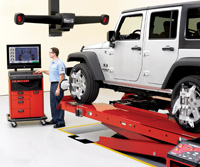 The Hawkeye systems use high-resolution cameras and an enhanced target design to improve performance and application. The advanced digital imaging technology and high-definiton wheel targets improve the field of view, which reduced the distance required from the front turnplates to the front bay wall to secure accurate alignment readings. This unequalled capability permits the system to be installed in a smaller bay space and perform alignments at almost any lift height without compromising the camera's ability to monitor the targets. The Hawkeye systems use high-resolution cameras and an enhanced target design to improve performance and application. The advanced digital imaging technology and high-definiton wheel targets improve the field of view, which reduced the distance required from the front turnplates to the front bay wall to secure accurate alignment readings. This unequalled capability permits the system to be installed in a smaller bay space and perform alignments at almost any lift height without compromising the camera's ability to monitor the targets.
The new wheel targets also improve productivity, while maintaining the durability to stand up to the shop environment. The smaller and lighter design makes the targets easier to handle and work around when making adjustments, saving time and effort. An impact-resistant housing and integrated bumpers protect against damage from accidental drops, along with a shatterproof aluminum faceplate that is corrosion resistant and virtually maintenance-free Like all Hunter camera-system targets, the Hawkeye targets contain no electronics and require no calibration.
Hunter's future products will be driven by the newest technology and designed to meet the requirements of the new century. The company's 600-person U.S. Field Organization, 950 franchised distributors and national accounts, and 100 overseas distributors all comprise one of the largest and most effective aftermarket equipment suppliers in the world. This global team remains dedicated to the principles established and proven by Lee Hunter back in 1937 when he first envisioned and successfully brought to market better, faster ways to solve problems with car repair - ways that the “experts” said couldn't be done.
|